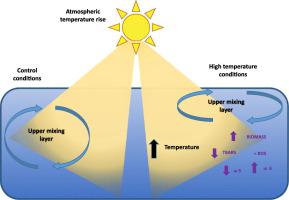当前位置:
X-MOL 学术
›
Comp. Biochem. Physiol. C Toxicol. Pharmacol.
›
论文详情
Our official English website, www.x-mol.net, welcomes your
feedback! (Note: you will need to create a separate account there.)
Differential sensitivity of fatty acids and lipid damage in Microcystis aeruginosa (cyanobacteria) exposed to increased temperature.
Comparative Biochemistry and Physiology C: Toxicology & Pharmacology ( IF 3.9 ) Pub Date : 2020-04-28 , DOI: 10.1016/j.cbpc.2020.108773 Florencia de la Rosa 1 , Marleen De Troch 2 , Gabriela Malanga 3 , Marcelo Hernando 4
Comparative Biochemistry and Physiology C: Toxicology & Pharmacology ( IF 3.9 ) Pub Date : 2020-04-28 , DOI: 10.1016/j.cbpc.2020.108773 Florencia de la Rosa 1 , Marleen De Troch 2 , Gabriela Malanga 3 , Marcelo Hernando 4
Affiliation

|
Changes in fatty acid (FA) composition can mean a mechanism of acclimation of Cyanobacteria to climate change. The objective of the present study was to evaluate the effects of increased temperature on M. aeruginosa cultures in terms of FA content, lipid damage, biomass and reactive oxygen species (ROS). Unicellular cultures were exposed to high (29 °C) and control (26 °C) temperature for 12 days. Differential sensitivity of ω3 FAs was observed after 2 days of exposure to elevated temperature (29 °C). Also, no significant differences in ROS content at different temperatures were observed although there was a significant decrease compared to the value at the start of the incubation. Thus, low FA peroxidation of selected ω6 PUFAs and potentially increased activation of antioxidant systems, resulting in lower lipid damage (on average 35%), could explain the strong acclimation to high temperature as shown by the increased growth rate (11%) compared to the control conditions. In high temperature conditions we found a retarded desaturation to 18:3ω3 and 18:4ω3 PUFAs which were 40% lower compared with control at the end of incubation. Overall, growth rate and omega-6 FA were increased at high temperature as a mechanism of successful acclimation. This is highly relevant for the ecological role of M. aeruginosa as food source for grazers. A reduced FA level can have serious implications for the flow of energy and thus the overall functioning of the ecosystem.
中文翻译:

暴露于高温下的铜绿微囊藻(蓝藻)中脂肪酸和脂质损伤的差异敏感性。
脂肪酸(FA)组成的变化可能意味着蓝细菌适应气候变化的机制。本研究的目的是根据FA含量,脂质损伤,生物量和活性氧(ROS)评估温度升高对铜绿假单胞菌培养物的影响。将单细胞培养物暴露于高温(29°C)和对照(26°C)下12天。暴露于高温(29°C)2天后,观察到ω3FAs的差分灵敏度。而且,尽管与孵育开始时的值相比有明显降低,但是在不同温度下没有观察到ROS含量的显着差异。因此,所选ω6PUFA的低FA过氧化作用和潜在增加的抗氧化剂系统活化作用,可降低脂质损伤(平均35%),可以解释为对高温的强烈适应,如与对照条件相比增长的增长率(11%)所示。在高温条件下,我们发现延迟的去饱和度降低至18:3ω3和18:4ω3PUFA,与温育结束时的对照相比,降低了40%。总体而言,高温和高Omega-6 FA的生长是成功驯化的机制。这与铜绿假单胞菌作为食草动物的食物来源的生态作用高度相关。降低的脂肪酸水平可能对能量流动以及生态系统的整体功能产生严重影响。在培养结束时,与对照相比,4ω3PUFA降低了40%。总体而言,高温和高Omega-6 FA的生长是成功驯化的机制。这与铜绿假单胞菌作为食草动物的食物来源的生态作用高度相关。降低的脂肪酸水平可能对能量流动以及生态系统的整体功能产生严重影响。在培养结束时,与对照相比,4ω3PUFA降低了40%。总体而言,高温和高Omega-6 FA的生长是成功驯化的机制。这与铜绿假单胞菌作为食草动物的食物来源的生态作用高度相关。降低的FA水平可能对能量流动以及生态系统的整体功能产生严重影响。
更新日期:2020-04-28
中文翻译:

暴露于高温下的铜绿微囊藻(蓝藻)中脂肪酸和脂质损伤的差异敏感性。
脂肪酸(FA)组成的变化可能意味着蓝细菌适应气候变化的机制。本研究的目的是根据FA含量,脂质损伤,生物量和活性氧(ROS)评估温度升高对铜绿假单胞菌培养物的影响。将单细胞培养物暴露于高温(29°C)和对照(26°C)下12天。暴露于高温(29°C)2天后,观察到ω3FAs的差分灵敏度。而且,尽管与孵育开始时的值相比有明显降低,但是在不同温度下没有观察到ROS含量的显着差异。因此,所选ω6PUFA的低FA过氧化作用和潜在增加的抗氧化剂系统活化作用,可降低脂质损伤(平均35%),可以解释为对高温的强烈适应,如与对照条件相比增长的增长率(11%)所示。在高温条件下,我们发现延迟的去饱和度降低至18:3ω3和18:4ω3PUFA,与温育结束时的对照相比,降低了40%。总体而言,高温和高Omega-6 FA的生长是成功驯化的机制。这与铜绿假单胞菌作为食草动物的食物来源的生态作用高度相关。降低的脂肪酸水平可能对能量流动以及生态系统的整体功能产生严重影响。在培养结束时,与对照相比,4ω3PUFA降低了40%。总体而言,高温和高Omega-6 FA的生长是成功驯化的机制。这与铜绿假单胞菌作为食草动物的食物来源的生态作用高度相关。降低的脂肪酸水平可能对能量流动以及生态系统的整体功能产生严重影响。在培养结束时,与对照相比,4ω3PUFA降低了40%。总体而言,高温和高Omega-6 FA的生长是成功驯化的机制。这与铜绿假单胞菌作为食草动物的食物来源的生态作用高度相关。降低的FA水平可能对能量流动以及生态系统的整体功能产生严重影响。











































 京公网安备 11010802027423号
京公网安备 11010802027423号